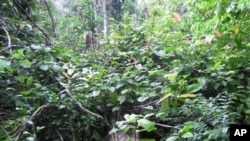In the American tropics, thick woody vines called lianas are outpacing trees. They're sucking up soil, nutrients and water, leaving less resources for the trees around them.
University of Wisconsin plant ecologist Stefan Schnitzer studies these aggressive, fast growing vines known as lianas.
"They are structural parasites," he says. "They use the architecture of the tree. They climb up the tree, and they put their leaves on top of the tree’s leaves."
Lianas help animals traverse the forest, escape predators and get food.
In the American tropics, the vines are increasing in numbers relative to trees, a trend documented by Schnitzer and colleagues in the journal Ecology Letters.
"Trees may be increasing or decreasing, but in any given forest lianas are increasing much more. This pattern has finally snapped into focus. We should all believe it now, because this is one of the first large scale structural changes occurring in tropical forests."
The researchers base their findings on eight studies of lowland tropical and subtropical forests in Central and South America. Schnitzer says a variety of factors could be at play.
"We think tropical forests in the Americans are drying out a little bit, which would favor liana proliferation. We think that elevated CO2 may also favor liana proliferation, especially under a slightly drier scenario, a drier climate."
Lianas also recover more quickly from changing land use like logging, and from the seasonal droughts that are becoming more common with global climate change. Schnitzer says more lianas could slow tree growth, accelerate tree death and lessen the amount of carbon a forest absorbs, since vines can’t store as much carbon as the trees they replace.
"What happens then is tropical forests will stop holding as much carbon in the form of bio-mass or tree trunks because there will be less growth, less carbon fixation and less carbon pulled out of the air, and that carbon will go back into the atmosphere. When that happens, we get additional climate change from elevated CO2 in the atmosphere."
The data also show that as the parasitic woody vines suck up soil nutrients and water to support their rapid growth, they are leaving less of those resources for their host trees to use. Stefan Schnitzer notes that the pattern he and his colleagues are seeing has not been documented outside of the American tropics.
The scientists are working with the Smithsonian Tropical Research Institute on large-scale vine removal experiments to better understand the lianas' impact.











